10+ Sample Medical Records Release Forms
-

Medical Record Release Information Form
download now -
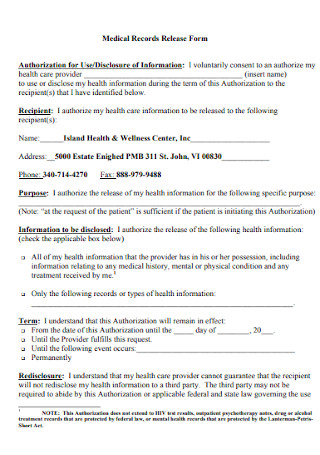
Medical Records Release Form
download now -
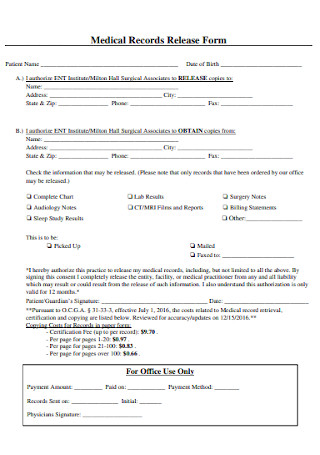
Medical Records Release Form Format
download now -
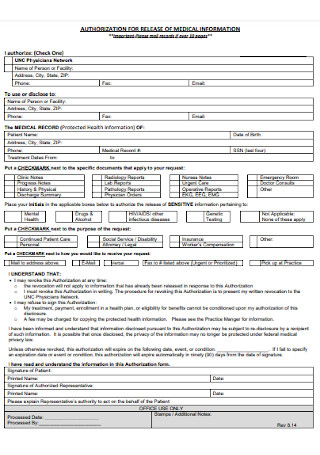
Authorization for Release of Medical Form
download now -
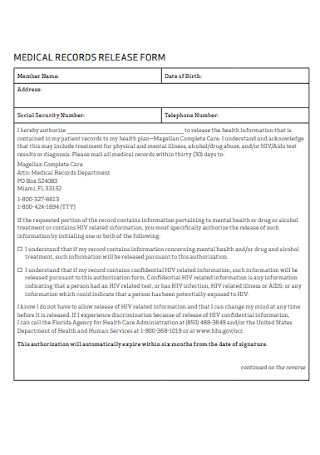
Medical Record Release Form Template
download now -
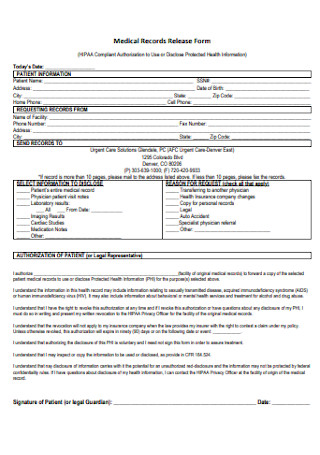
Simple Medical Records Release Form
download now -
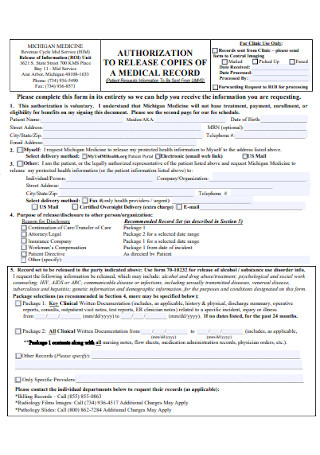
Medical Record Copies Release Form
download now -
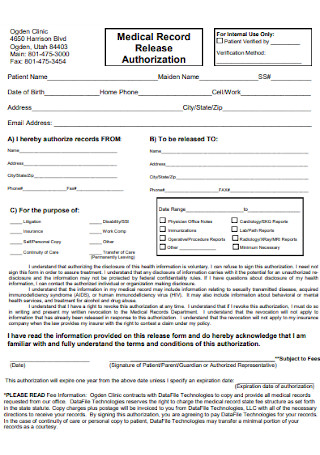
Medical Record Release Authorization Form
download now -
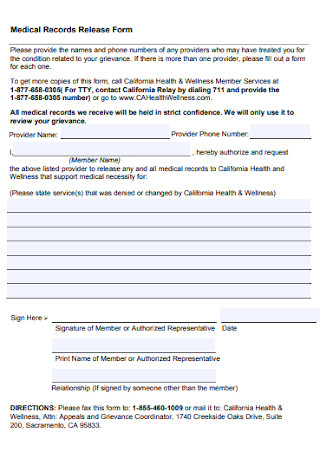
Formal Medical Records Release Form
download now -
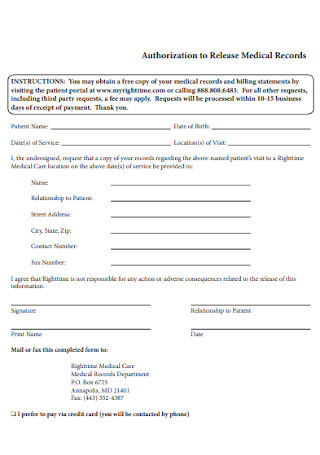
Authorization to Release Medical Records Form
download now -
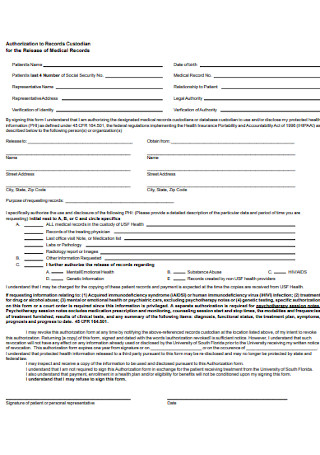
Standard Medical Record Releae Form
download now
FREE Medical Records Release Form s to Download
10+ Sample Medical Records Release Forms
What Is a Medical Release Form?
Elements To Include In a Medical Records Release Form
How To Create Medical Records Release Form
FAQs:
What are the consequences of not using a medical records release form?
How can I obtain a deceased relative’s medical records?
Is it possible for my spouse to obtain my medical records?
Is a copy of my medical records sent to my primary care physician?
Who should sign a minor child’s record release?
Health practitioners must not reveal a patient’s information without a legal authorization, except in restricted instances as necessary or permitted by law, according to the federal Health Insurance Portability and Accountability Act of 1996 (HIPAA) and state legislation. Before protected health information is exposed, HIPAA laws require covered entities to obtain a HIPAA medical release form (or medical records release authorization form). States are allowed to enact HIPAA-equivalent medical release form legislation as long as the state HIPAA medical release form laws protect patient privacy at least as well as the HIPAA requirements. A medical release form will be required, in most cases wherein, a provider must seek written authorization from the patient (or the patient’s personal representative) before disclosing protected health information for reasons other than payment, treatment, or healthcare operations.
A HIPAA medical release form is a frequent name for the written authorization form (or medical records release authorization form). Before any protected health information can be disclosed, the authorization must be acquired. There are some instances where a medical release form will be required if it is prior to any disclosure of protected health information to a third party for any cause other than treatment, payment, or the running of a healthcare facility, before sharing protected health information that could be utilized for marketing or fundraising purposes, prior to providing protected health information (PHI) for research purposes, before any psychotherapy notes are revealed, prior to the disclosure or sharing of PHI for monetary gain. Are you looking for some printable, blank medical release form templates that you can use for the hospital or your personal use? If yes, then you came to the right website. Browse through our different templates below that you can use and download and editable according to how you want to use it! Are you skeptical on how you are going to use a medical release form? If your answer is still yes, scroll down below to get to know more about a medical release form, how to create one and the frequently asked questions of it.
What Is a Medical Release Form?
A Medical Records Release Form (also known as a Medical Information Release Form) is a document that asks a health care provider (such as a doctor, dentist, hospital, chiropractor, psychiatrist, or other professional) to release a patient’s medical records to the patient, a third party (such as an employer, insurance company, or both), or both. Each state has its unique set of medical release laws. These laws specify when a signed patient authorization is required for the use or disclosure of medical records. Some state laws provide greater protection for patient privacy than others. For example, some states have stricter rules about when providers can release patient details without permission than others. This is where the Health Insurance Portability and Accountability Act (HIPAA) comes into play.
Elements To Include In a Medical Records Release Form
There are various elements that should be included in a medical records release form that you should also be familiar with. Listen down below are the common elements that can be found in a medical records release form:
How To Create Medical Records Release Form
When it comes to healthcare, being able to provide and manage accurate and detailed paperwork is crucial to not just providing excellent patient care but also keeping legally compliant. A medical records release form is one type of documentation that is commonly requested in a healthcare setting. A medical records release form is a document that permits you to disclose patient information with a third party, such as an employer, insurance company, family member, another doctor or healthcare provider, or other third party. Are you planning to get your medical record? Read down below to know how.
1. Download or acquire a medical record template
You can get a medical record template from the hospital, physician or you can also download one online. You can download printable and editable templates also from this website that you can use as your medical record.
2. Create the patient data that was requested in the introduction.
On the blank section labeled “Print Name Of Patient,” enter the patient’s entire name as it appears on his or her I.D. cards. Additional information will be required in most cases to completely identify the Patient. On the “Date of Birth” line, write his or her birth date, as well as his or her social security number in the “SSN” blank box.
3. Who Can Receive Information From This Document
Look for the section under “I. Authorization.” Fill in the first blank line in this section with the name of the person (Disclosing Party) who will be permitted to reveal the Patient’s medical records via this form and the Health Insurance Portability And Accountability Act of 1996. Ascertain that the Disclosing Party’s name is reported exactly as it appears on his or her identity papers (e.g., driver’s license).
4. Report What Kinds Of Information Your Agent Might Get, Use, And Disseminate
We’ll need to clarify what information the Patient is comfortable sharing now that we’ve identified the organization that requires the Patient’s consent. If there are checkboxes in your template, you may mark the checkbox if the patient wants the Disclosing Party to have access to all of his or her medical information. Mark the checkbox and report the nature of the information that can be released on the blank line after the words.” If the Patient only wants information relevant to a specific subject released by the Disclosing Party, then mark the checkbox and report the nature of the information that can be released on the blank line after the words.”
5. A patient’s valid authorization signature must be present
Only after reading the entire text, including the section under “II. Rights,” should the Patient sign this paper. The Patient must then sign the blank line labeled “Signature Of Patient” once this is completed. This paperwork demands the signature of a competent adult in his or her right mind. If the Patient is a minor or does not have the legal capacity to represent himself or herself, a legal representative of the Patient must also sign this paper.
FAQs:
What are the consequences of not using a medical records release form?
It is the responsibility of health care practitioners to ensure that information is only shared with those who have been officially authorized. The overarching consequence of not using a release is that the information will not be released by the health provider. Patients have the right to sue anyone who exposes their personal information without their permission. As a result, without a valid records release, health providers will not release any information. If you’re not sure if a record release is necessary, get one signed anyway because it will speed up the release of information.
How can I obtain a deceased relative’s medical records?
The Personal Representative of the deceased individual’s Estate has the authority to authorize the release of the deceased’s medical records. Before records can be disclosed, the Personal Representative must be designated by the Probate Court and bring documentation of the appointment. After a patient’s death, documents such as a Durable Power of Attorney or a designation as a decision-maker in an Advance Directive are no longer valid. If there is no legal representative, authorizations from the following individuals may be accepted in the following terms of priority, the spouse, son or daughter, either of the parents or brother or sister. In addition, records on deceased people can be provided directly to life insurance companies for benefit payout.
Is it possible for my spouse to obtain my medical records?
No, only if you or your legal representative have obtained a formal authorization stating that your medical records may be provided to that specific individual. Except for continuous patient treatment directly to a physician’s office or healthcare institution, or in the event of a medical emergency, medical records will not be released without prior authorization.
Is a copy of my medical records sent to my primary care physician?
The answer changes based on a number of criteria.
In the case of in-patient care, if your family physician is also your attending physician while you are in the hospital, they will have access to and copies of any pertinent reports as the attending physician. An attending physician is the doctor who is in charge of your medical treatment while you are in the hospital. If your attending physician is not your primary care physician, they may not receive copies of your reports automatically. Typically, the attending physician requests that copies be given to your primary care provider. This is handled on a case-by-case basis in most cases.
Copies of reports are sent to the physician who ordered the test for outpatient care or testing – A copy will be sent to your family physician if this is the case. If they are ordered by another physician, your family physician will only receive copies if the ordering physician specifically requests that a copy be sent to them. As needed, your family physician can contact us for copies of reports from your medical record. As long as that is your primary care provider, no authorization is required. If you’re seeing a new doctor for the first time, we may need you to sign a consent form to ensure that sending copies is okay. This is necessary in order to maintain patient confidentiality.
Who should sign a minor child’s record release?
With some circumstances, natural parents of minors have an equal right to their child’s medical information, as required by law. They can only be refused access if their parental rights have been taken away. To facilitate the denial, we must be aware of the lack of parental rights. Only the natural mother has the ability to sign the release of information authorisation when the natural parents have never married, unless otherwise directed by a court order. The father does not have the ability to authorize the release of records if he signs an Acknowledgement of Paternity. Stepparents do not have the legal authority to consent to the release of a minor child’s medical records without a court order. Adoptive parents are the parents of an adopted kid who are not the biological parents of the child. The original parents’ parental rights have been terminated, so an adoptive parent must obtain approval for the release of a minor child’s medical record.
Medical release forms are critical for both you and your patients’ safety. The form aids in the protection of the patient’s privacy and right to willingly share personal information. It also safeguards your right to consent to the dissemination of information.
